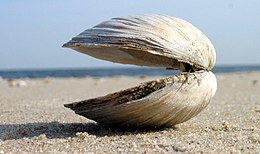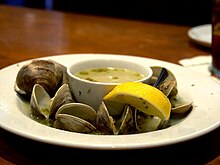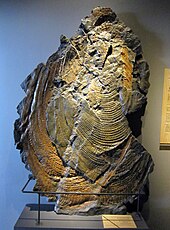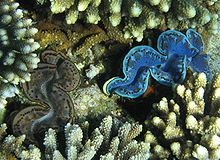How To Remove A Pearl Without Killing The Oyster

Clam is a common proper name for several kinds of bivalve molluscs. The give-and-take is frequently applied only to those that are edible and live every bit infauna, spending virtually of their lives halfway buried in the sand of the seafloor or riverbeds. Clams accept two shells of equal size connected by two adductor muscles and accept a powerful burrowing pes.[i] They live in both freshwater and marine environments; in salt water they prefer to couch down into the mud and the turbidity of the water required varies with species and location; the greatest diversity of these is in Northward America.[ii]
Clams in the culinary sense do not live attached to a substrate (whereas oysters and mussels do) and do non live near the bottom (whereas scallops do). In culinary usage, clams are usually eaten marine bivalves, equally in clam excavation and the resulting soup, clam chowder. Many edible clams such as palourde clams are ovoid or triangular;[3] however, razor clams have an elongated parallel-sided vanquish, suggesting an one-time-fashioned straight razor.[four]
Some clams have life cycles of only ane twelvemonth, while at least 1 may be over 500 years quondam.[five] All clams take two calcareous shells or valves joined near a hinge with a flexible ligament and all are filter feeders.
Beefcake [edit]

A clam'due south shell consists of two (usually equal) valves, which are connected by a swivel articulation and a ligament that tin exist internal or external. The ligament provides tension to bring the valves apart, while one or two adductor muscles can contract to close the valves. Clams also accept kidneys, a heart, a rima oris, a stomach, and a nervous system. Many accept a siphon.
Food source and ecology [edit]


Clams are shellfish that make upwardly an important part of the spider web of life that keeps the seas functioning, both equally filter feeders and every bit a food source for many unlike animals.[6] Extant mammals that eat clams would include both the Pacific and Atlantic species of walrus, all known subspecies of harbour seals in both the Atlantic and Pacific, near species of sea lions, including the California sea lion, bearded seals and even species of river otters that will consume the freshwater species found in Asia and Northward America.[vii] Birds of all kinds will besides eat clams if they can grab them in the littoral zone: roseate spoonbills of Due north and South America,[8] the Eurasian oystercatcher, whooping crane[ix] and mutual crane, the American flamingo of Florida and the Caribbean Bounding main,[10] and the common sandpiper are simply a handful of the numerous birds that feast on clams all over the world. Most species of octopus have clams every bit a staple of their diet, up to and including the giants similar the Behemothic Pacific octopus.
Culinary [edit]
Cultures around the world eat clams forth with many other types of shellfish.
Northward America [edit]
In culinary use, inside the eastern coast of the United states and large swathes of the Maritimes of Canada, the term "clam" most oftentimes refers to the hard mollusk, Mercenaria mercenaria. It may besides refer to a few other common edible species, such equally the soft-shell clam, Mya arenaria, and the bounding main quahog, Arctica islandica. Another species commercially exploited on the Atlantic Declension of the United States is the surf clam, Spisula solidissima. Scallops are also used for food nationwide, but non cockles: they are more difficult to get than in Europe because of their habit of being farther out in the tide than European species on the West Declension, and on the Eastward Declension they are often found in salt marshes and mudflats where mosquitoes are abundant.[11] In that location are several edible species in the Eastern United States: Americardia media, also known as the strawberry cockle, is plant from Greatcoat Hatteras downwards into the Caribbean Sea and all of Florida; Trachycardium muricatum has a similar range to the strawberry crinkle; and Dinocardium robustum, which grows to exist many times the size of the European crinkle.[12] Historically, they were caught on a small-scale calibration on the Outer Banks, barrier islands off N Carolina, and put in soups, steamed or pickled.[13]
Up and downwardly the declension of the Eastern U.S., the bamboo mollusk, Ensis directus, is prized by Americans for making mollusk strips, although because of its nature of burrowing into the sand very close to the beach, information technology cannot be harvested by mechanical means without dissentious the beaches.[14] The bamboo clam is as well notorious for having a very sharp edge of its shell, and when harvested past manus must exist handled with great intendance.
On the U.S. West Declension, there are several species that accept been consumed for thousands of years, evidenced by middens full of clamshells near the shore and their consumption by nations including the Chumash of California, the Nisqually of Washington land and the Tsawwassen of British Columbia.[fifteen] The butter clam, Saxidomus gigantea,[sixteen] the Pacific razor mollusk, Siliqua patula, [17] gaper clams Tresus capax,[18] the geoduck mollusk, Panopea generosa [xix] and the Pismo mollusk, Tivela stultorum [20] are all eaten as delicacies.
Clams tin can exist eaten raw, steamed, boiled, baked or fried. They can besides be fabricated into clam chowder, clams casino, clam cakes, or stuffies, or they can be cooked using hot rocks and seaweed in a New England clam bake. On the West Declension, they are an ingredient in making cioppino and local variants of ceviche[21]
Asia [edit]
Bharat [edit]
Clams are eaten more than in the coastal regions of Republic of india, especially in the Konkan, Kerala, Bengal and coastal regions of Karnataka, Tamil Nadu regions.[ citation needed ]
In Kerala clams are used to brand curries and fried with coconut. In the Malabar region information technology is known every bit "elambakka" and in middle kerala information technology is known as "kakka". Clam curry made with coconut is a dish from Malabar especially in the Thalassery region. On the southwestern coast of India, also known as the Konkan region of Maharashtra, clams are used in curries and side dishes, like Tisaryachi Ekshipi, which is clams with one shell on. Beary Muslim households in the Mangalore region prepare a main dish with clams called Kowldo Pinde. In Udupi and Mangalore regions it is chosen "marvai" in the local Tulu language. It is used to prepare many dishes similar marvai sukka, marvai gassi, and marvai pundi.[ citation needed ]
Nihon [edit]
In Japan, clams are often an ingredient of mixed seafood dishes. They can also exist made into hot pot, miso soup or tsukudani. The more unremarkably used varieties of clams in Japanese cooking are the Shijimi (Corbicula japonica), the Asari (Venerupis philippinarum) and the Hamaguri (Meretrix lusoria).[ citation needed ]
Europe [edit]
Slap-up Uk [edit]
The rocky terrain and pebbly shores of the seacoast that surrounds the entire isle provides ample habitat for shellfish, and clams are most definitely included in that description. The oddity hither is that for a nation whose fortunes take been tied to the ocean for hundreds of years, 70% of the seafood cultivated for aquaculture or commercial harvesting is exported to the Continent.[22] Historically, Britain has been an island most famous for its passion for beef and dairy products, although there is evidence going back to before well-nigh recorded history of coastal beat middens near Weymouth and present twenty-four hours York.[23] (There is also evidence of more thriving local trade in sea products in full general by noting the Worshipful Company of Fishmongers was founded in 1272 in London.) Present-twenty-four hour period younger populations are eating more of the grab than a generation ago, and there is a prevalence of YouTube videos of locavore scavenging; even so, the numbers have a long way to go before they lucifer the numbers consumed in the Mesolithic, every bit evidenced by the strikingly large number of shells found in middens.
Staple favourites of the British public and local scavengers include the razorfish, Ensis siliqua, a slightly smaller cousin of the bamboo clam of eastern North America.[24] These can be found for sale in open-air markets like Billingsgate Market in London; they have a similar taste to their North American cousin.[25] Cockles, specifically the mutual cockle, are a staple find on beaches in western Wales and farther north in the Dee Estuary. The accidentally introduced difficult-shell mercenaria mercenaria is also found in British waters, mainly those near England, and does run across some employ in British cuisine. The Palourde clam by far is the most common native clam and information technology is both commercially harvested too equally locally collected, and Spisula solida, a relative of the Atlantic surf mollusk on the other side of the Atlantic, is seeing increased interest as a nutrient source and aquaculture candidate; it is mainly found in the British Isles in Europe.[26]
Italy [edit]
In Italia, clams are often an ingredient of mixed seafood dishes or are eaten together with pasta. The more than normally used varieties of clams in Italian cooking are the vongola (Venerupis decussata), the cozza (Mytilus galloprovincialis) and the tellina (Donax trunculus). Though dattero di mare (Lithophaga lithophaga) was one time eaten, overfishing drove it to the verge of extinction (information technology takes fifteen to 35 years to reach adult size and could but be harvested past bang-up the calcarean rocks that form its habitat) and the Italian government has declared information technology an endangered species since 1998 and its harvest and sale are forbidden.[ citation needed ]
Religion [edit]
In Judaism, clams are considered non-kosher (treif); but in Islam, clams are considered Halal. In Jainism, eating clams is confronting the principles of 'ahinsa' or not-violence, every bit information technology is a result of killing (hinsa) a living creature.
As currency [edit]
Some species of clams, particularly Mercenaria mercenaria, were in the past used by the Algonquians of Eastern North America to manufacture wampum, a type of sacred jewellery; and to brand shell money.[27]
Species [edit]


Edible:
- Ark clams, family Arcidae (nearly popular in Indonesia and Singapore)
- Atlantic jackknife mollusk: Ensis directus
- Atlantic surf clam: Spisula solidissima
- Common cockle: Cerastoderma edule (Native to nearly of Europe, with very large populations in Ireland and Uk)
- Atlantic Giant Crinkle: Dinocardium robustum
- Geoduck: Panopea abrupta or Panope generosa (largest burrowing clam in the world)
- Gould's razor shell, Solen strictus (popular in Korea, Japan, and Taiwan)
- Grooved carpet shell: Ruditapes decussatus
- Hard clam or Northern Quahog: Mercenaria mercenaria (Native to Eastern United states and Maritime Canada)
- Lyrate Asiatic hard clam: Meretrix lyrata
- Manila clam: Venerupis philippinarum
- Ocean quahog: Arctica islandica
- Pacific razor clam: Siliqua patula
- Pipis, Plebidonax deltoides and Paphies australis
- Pismo clam: Tivela stultorum
- Pod razor clam: Ensis siliqua
- Spoot: Ensis magnus
- Soft clam: Mya arenaria
Not usually considered edible:
- Nut clams or pointed nut clams, family Nuculidae
- Duck clams or trough shells, family Mactridae
- Marsh clams, family Corbiculidae
- File clams, family unit Limidae
- Behemothic clam: Tridacna gigas This clam is native to East asia and is edible, only should be avoided at all costs because of slow reproduction.
- Asian or Asiatic clam: genus Corbicula
- Fiery furrow trounce: Scrobicularia plana
See also [edit]
- Clam juice – Broth obtained from clams
- List of clam dishes – dishes and foods prepared using clams
- Shipworm – Family of molluscs
- Water purification – Process of removing undesirable chemicals, biological contaminants, suspended solids from water
- Mussel – Type of bivalve mollusc
References [edit]
- ^ "Clam". Encyclopædia Britannica. Encyclopædia Britannica. 2022.
- ^ "Can Y'all Eat Freshwater Clams in the Nature?". 29 April 2022.
- "Musseling in". Baronial 2022.
- "USFWS: America's Mussels". - ^ "Clams recipes". BBC Food . Retrieved 23 February 2022.
- ^ "Clam". Lexico. Oxford.
- ^ Danielle Elliot (14 November 2022). "Ming the Mollusk, World's Oldest Animal, Was Really 507 Years Old". CBS News. Archived from the original on 20 November 2022. Retrieved xv November 2022.
- ^ "Outreach & Education" (PDF). NOAA Fisheries. xi June 2022.
- ^ "River Otters". Due west Sound Wildlife. Archived from the original on 11 February 2022. Retrieved 23 January 2022.
- "Asian small-clawed otter". Marwell Zoo. Retrieved eight November 2022. - ^ "Roseate Spoonbill". Birds of Ambergris Caye.
- ^ "Whooping Crane". National Geographic. 11 November 2010.
- ^ "The Birds of Bonaire". Bonaire.
- ^ "Clams". Fishing & Shellfishing. Washington Section of Fish & Wildlife. Archived from the original on xvi March 2022. Retrieved 8 November 2022.
- "Crinkle". SeafoodSource. Diversified Communications. 23 Jan 2022. - ^ "Atlantic Giant Cockle (Dinocardium robustum)". College of Charleston. Retrieved 8 Nov 2022.
- ^ Smith, Prudence (1831). Modern American Cookery ... With a listing of family medical recipes, and a valuable miscellany. J. and J. Harper. p. 109 – via Google Books.
- ^ "dredging of clams" (PDF). Archived from the original (PDF) on 16 March 2022. Retrieved 16 March 2022.
- ^ "Vanquish Midden Analysis". Science Encyclopedia . Retrieved x March 2022.
- "Nisqually People and the River". Yelm History Projection. Retrieved 10 March 2022.
- Sophia Cross (29 September 2022). "What Did the Chumash Eat?". Classroom . Retrieved eight November 2022.
- "Tsawwassen First Nation History and Timeline". Tsawwassen First Nation. ten November 2022. Archived from the original on 11 November 2022. Retrieved x November 2022. - ^ Mark Yuasa (27 June 2022). "Enough of clams, oysters in Puget Sound and Hood Culvert". The Seattle Times . Retrieved viii November 2022.
- ^ Kelly, Mike (1 February 2022). "Dig Those Razor Clams". North Coast Journal . Retrieved eight November 2022.
- ^ Lackner, Bill. "Oregon clam chowder". Coos Bay World . Retrieved 10 March 2022.
- ^ Naomi Tomky (10 Baronial 2022). "All Most Geoduck: The Life of a (Delicious) Oversized Mollusk". serious eats . Retrieved viii November 2022.
- ^ Christopher Young (12 April 2022). "Digging for Pismo clams at San Diego Beaches". San Diego Reader . Retrieved 8 November 2022.
- ^ Langdon Cook. "razor clams". Retrieved 16 March 2022.
- ^ Louise Harkell (10 Apr 2022). "Merchandise insights: More than 70% of UK seafood exports go to European union". undercurrent news . Retrieved 8 Nov 2022.
- ^ Thomas, Ken; Mannino, Marcello (1998). "Mesolithic middens and molluscan ecology: A view from southern Britain". Archaeology International. two: 17. doi:ten.5334/ai.0207.
- ^ "Razorfish". British Body of water Fishing. 12 October 2022.
- ^ "Razor Clams on display in Billingsgate Fish Market, London". Alamy.
- ^ Joaquim, Sandra; Matias, Domitília; Matias, Ana Margarete; Gonçalves, Rui; Chícharo, Luís; Gaspar, Miguel B. (2016). "New species in aquaculture: Are the striped venus clam Chamelea gallina(Linnaeus, 1758) and the surf mollusk Spisula solida(Linnaeus 1758) potential candidates for diversification in shellfish aquaculture?". Aquaculture Research. 47 (4): 1327–1340. doi:10.1111/are.12593.
- ^ Kurlansky, Mark (2006), The Big Oyster: History on the Half Shell, Penguin Group, pp. xvi, thirty–31, ISBN978-0-345-47638-8, OCLC 60550567.
External links [edit]
| | Await up clam in Wiktionary, the costless dictionary. |
| | Wikimedia Commons has media related to Clams. |
- "Deep In The Body of water A Clam That Acts Similar A Establish" Science Daily March 2, 2007
- Hardshell Clams
Source: https://en.wikipedia.org/wiki/Clam

0 Response to "How To Remove A Pearl Without Killing The Oyster"
Post a Comment